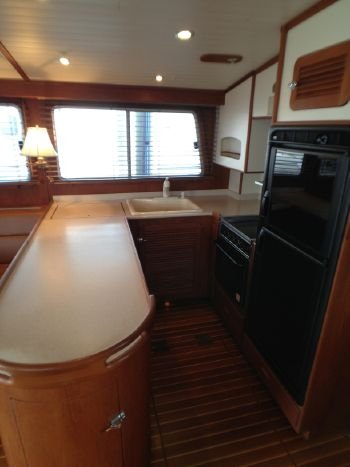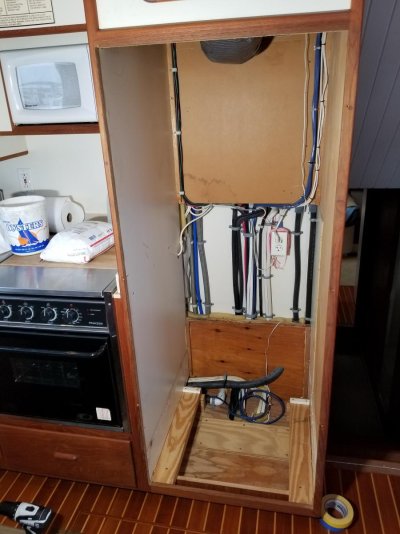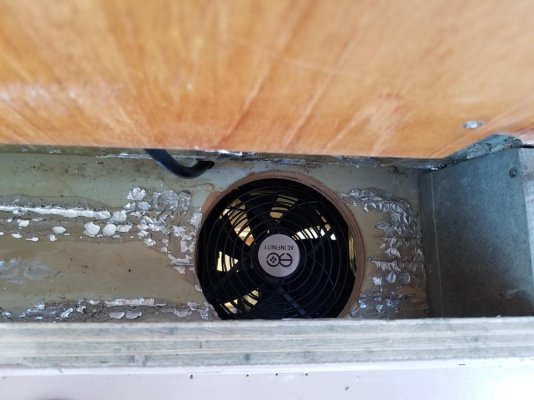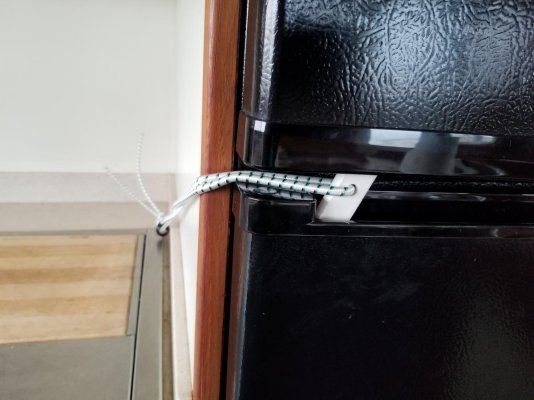O C Diver
Guru
- Joined
- Dec 16, 2010
- Messages
- 13,318
- Location
- Fort Myers, Florida
- Vessel Name
- End Of The Line
- Vessel Make
- Trinka 10 Dinghy
A little background:
I had a Norcold DE/EV 0061 7.0 cuft AC/DC refrigerator. The gasket on the freezer door didn't seal completely necessitating that I defrost it every one to two weeks. The gasket isn't sold separately, but you can buy the whole door assembly for a princely sum. I had my suspicion that it was an energy hog, but never did an extensive consumption test. This is an older unit, and I'm led to believe the newer ones have Danfoss compressors, are more efficient. Also, I felt that if there were 4 of us cruising, the size was a little small.
So I started looking at other marine / RV refrigerators. They start around $1,500 for similar size and go up from there. No information is available for how good the insulation is or real power consumption numbers such as the standard USA Energyguide. Simply, you spend a lot of money and hope the salesman / brochure aren't lying too much.
Decided it was time to start looking at alternatives. There are quite a number of apartment refrigerators that start around $350 and have the USA Energyguide, so you have some idea of how efficient they are. While doing my research, I found that some units are FROST FREE.
Going with an apartment refrigerator adds several hurdles. Most RV / marine refrigerators front surface mount and are less than 24" wide. Most apartment refrigerators are free standing and are 24" wide or greater. Almost none of the apartment refrigerators are designed to be built into a cabinet. Then there is the power supply issue. Didn't find any apartment refrigerators that used 12 volts DC. Last issue is locking doors. Apparently apartment refrigerators aren't subject to pitching and rolling. Pulling out the Norcold and replacing it with an apartment unit wasn't going to be plug and play.
Pulling out the Norcold and replacing it with an apartment unit wasn't going to be plug and play.
You probably guessed by the title of the thread that I found one and made it work, and you would be right. Did a lot of research and made a ridiculous amount of measurements. Looked at lots of units, formulated remodeling plans, and then started all over again. Here's what I bought:
Summit Appliances FF1119B
It's a 10.0 cuft FROST FREE refrigerator with a "Most Efficient" energy rating for 2017. Now the fun starts. Put a 10 cuft refrigerator in the same place where a 7 cuft unit was.
Here are the only 2 pics I have that show the Norcold. Notice the drawer underneath the fridge, about worthless.


Removal was pretty easy as I'd had it out during my refit project. Too get the new one in, the drawer had to go. New rails to set the unit on had to be fabricated (cut and mounted some 2 X 4s).The trickier part was cutting 3/8"+ off the teak trim on the left side of the cabinet and peeling some laminant off the inside to make it wide enough.


In this last pic you can see the Starboard stops at the end of the rails that limit backward travel. Also, you can see the airflow path in the front. Air goes under an original wood piece in the front, up over the bottom of the cabinet, between the rails, under the refrigerator and compressor, and then up the back across the condenser. Using rails instead of a solid piece of plywood was critical for airflow and cooling.

Next part is cooling a unit that isn't designed to be built in. The manufacturer is emphatic that this unit can't be built in! I like a challenge! Above the back of the refrigerator is the seat back in the pilothouse. An air conditioner vents through a slotted board atop the back of the seat. I opened the slots up for the AC and put a divider in so I could use some of the slots to vent the refrigerator.

In the space below the slotted board, I bored a hole to mount a 4"+ fan to provide ventilation.
AC Infinity Fan
This fan is very quiet (18 dBA) and uses 1.6 watts of electricity.

End of 1st post. I need to get to bed as I'm getting underway at 7am tomorrow, moving my trawler to FL. Will try to post the second half tomorrow evening.
Ted
I had a Norcold DE/EV 0061 7.0 cuft AC/DC refrigerator. The gasket on the freezer door didn't seal completely necessitating that I defrost it every one to two weeks. The gasket isn't sold separately, but you can buy the whole door assembly for a princely sum. I had my suspicion that it was an energy hog, but never did an extensive consumption test. This is an older unit, and I'm led to believe the newer ones have Danfoss compressors, are more efficient. Also, I felt that if there were 4 of us cruising, the size was a little small.
So I started looking at other marine / RV refrigerators. They start around $1,500 for similar size and go up from there. No information is available for how good the insulation is or real power consumption numbers such as the standard USA Energyguide. Simply, you spend a lot of money and hope the salesman / brochure aren't lying too much.
Decided it was time to start looking at alternatives. There are quite a number of apartment refrigerators that start around $350 and have the USA Energyguide, so you have some idea of how efficient they are. While doing my research, I found that some units are FROST FREE.

Going with an apartment refrigerator adds several hurdles. Most RV / marine refrigerators front surface mount and are less than 24" wide. Most apartment refrigerators are free standing and are 24" wide or greater. Almost none of the apartment refrigerators are designed to be built into a cabinet. Then there is the power supply issue. Didn't find any apartment refrigerators that used 12 volts DC. Last issue is locking doors. Apparently apartment refrigerators aren't subject to pitching and rolling.
You probably guessed by the title of the thread that I found one and made it work, and you would be right. Did a lot of research and made a ridiculous amount of measurements. Looked at lots of units, formulated remodeling plans, and then started all over again. Here's what I bought:
Summit Appliances FF1119B
It's a 10.0 cuft FROST FREE refrigerator with a "Most Efficient" energy rating for 2017. Now the fun starts. Put a 10 cuft refrigerator in the same place where a 7 cuft unit was.

Here are the only 2 pics I have that show the Norcold. Notice the drawer underneath the fridge, about worthless.


Removal was pretty easy as I'd had it out during my refit project. Too get the new one in, the drawer had to go. New rails to set the unit on had to be fabricated (cut and mounted some 2 X 4s).The trickier part was cutting 3/8"+ off the teak trim on the left side of the cabinet and peeling some laminant off the inside to make it wide enough.


In this last pic you can see the Starboard stops at the end of the rails that limit backward travel. Also, you can see the airflow path in the front. Air goes under an original wood piece in the front, up over the bottom of the cabinet, between the rails, under the refrigerator and compressor, and then up the back across the condenser. Using rails instead of a solid piece of plywood was critical for airflow and cooling.

Next part is cooling a unit that isn't designed to be built in. The manufacturer is emphatic that this unit can't be built in! I like a challenge! Above the back of the refrigerator is the seat back in the pilothouse. An air conditioner vents through a slotted board atop the back of the seat. I opened the slots up for the AC and put a divider in so I could use some of the slots to vent the refrigerator.

In the space below the slotted board, I bored a hole to mount a 4"+ fan to provide ventilation.
AC Infinity Fan
This fan is very quiet (18 dBA) and uses 1.6 watts of electricity.

End of 1st post. I need to get to bed as I'm getting underway at 7am tomorrow, moving my trawler to FL. Will try to post the second half tomorrow evening.
Ted




 I have seamless power for the refrigerator. The fan's 1.6 watt power consumption seems to be within the inverter's minimum consumption (inverter doesn't know it's there). The conclusion I came to was that there was no energy savings for using a smaller 2nd inverter. The redundancy plan is to simply run the generator until reaching shore power. Will talk more about energy consumption later. The old refrigerator ran off the battery bank when 120 VAC wasn't available. The new unit does the same (through the inverter), only uses significantly less.
I have seamless power for the refrigerator. The fan's 1.6 watt power consumption seems to be within the inverter's minimum consumption (inverter doesn't know it's there). The conclusion I came to was that there was no energy savings for using a smaller 2nd inverter. The redundancy plan is to simply run the generator until reaching shore power. Will talk more about energy consumption later. The old refrigerator ran off the battery bank when 120 VAC wasn't available. The new unit does the same (through the inverter), only uses significantly less.
